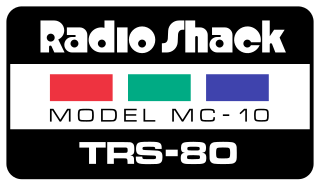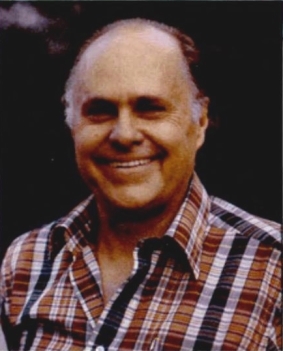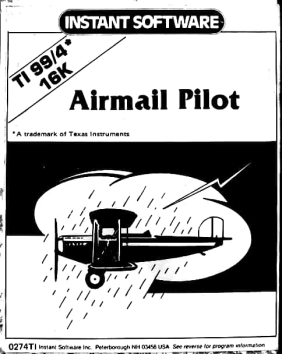
The TRS-80 Micro Computer System is a desktop microcomputer launched in 1977 and sold by Tandy Corporation through their Radio Shack stores. The name is an abbreviation of Tandy Radio Shack, Z80 [microprocessor]. It is one of the earliest mass-produced and mass-marketed retail home computers.

The RadioShack TRS-80 Color Computer, later marketed as the Tandy Color Computer, is a series of home computers developed and sold by Tandy Corporation. Despite sharing a name with the earlier TRS-80, the Color Computer is a completely different system and a radical departure in design based on the Motorola 6809E processor rather than the Zilog Z80 of earlier models.
Tandy Corporation was an American family-owned leather-goods company based in Fort Worth, Texas, United States. Tandy Leather was founded in 1919 as a leather supply store. By the end of the 1950s, under the tutelage of then-CEO Charles Tandy, the company expanded into the hobby market, making leather moccasins and coin purses, making huge sales among Scouts, leading to a fast growth in sales.

VisiCalc is the first spreadsheet computer program for personal computers, originally released for Apple II by VisiCorp on October 17, 1979. It is considered the killer application for the Apple II, turning the microcomputer from a hobby for computer enthusiasts into a serious business tool, and then prompting IBM to introduce the IBM PC two years later. More than 700,000 copies were sold in six years, and up to 1 million copies over its history.

The TRS-80 MC-10 microcomputer is a lesser-known member of the TRS-80 line of home computers, produced by Tandy Corporation in the early 1980s and sold through their RadioShack chain of electronics stores. It was a low-cost alternative to Tandy's own TRS-80 Color Computer to compete with entry-level machines such as the VIC-20 and Sinclair ZX81.

The TRS-80 Model 100 is a notebook-sized portable computer introduced in April 1983. It was the first commercially successful notebook computer, as well as one of the first notebook computers ever released. It features a keyboard and liquid-crystal display, in a battery-powered package roughly the size and shape of a notepad or large book. The 224-page, spiral-bound User Manual is nearly the same size as the computer itself.
Ohio Scientific, Inc., was a privately owned American computer company based in Ohio that built and marketed computer systems, expansions, and software from 1975 to 1986. Their best-known products were the Challenger series of microcomputers and Superboard single-board computers. The company was the first to market microcomputers with hard disk drives in 1977.

EACA International Ltd was a Hong Kong manufacturer active from 1975 to 1983, producing Pong-style television video games, and later producing thousands of personal computers.

Video Genie is a discontinued series of computers produced by Hong Kong-based manufacturer EACA during the early 1980s. Computers from the Video Genie line are mostly compatible with the Tandy TRS-80 Model I computers and can be considered a clone, although there are hardware and software differences.

Scripsit is a word processing application written for the Radio Shack TRS-80 line of computers. Versions were available for most if not all computers sold under the TRS-80 name, including the TRS-80 Color Computer and several pocket computer designs, as well as the Tandy version of the Xenix operating system. Tandy Corp. also produced a version running under MS-DOS for its line of PC compatible computers. Some of the 8-bit versions are tape-based and have no ability to read or write to disk.

Kilobaud Microcomputing was a magazine dedicated to the computer homebrew hobbyists from 1977 to 1983. It was one of the three influential computer magazines of the 1970s, along with BYTE and Creative Computing. It focused mostly on the kit-build market, rather than the pre-assembled home computers that emerged, and as the kit market declined in the early 1980s, Kilobaud lost relevance and closed in 1983. After this, company continued publishing other magazines dedicated to particular platforms rather than the kit market.
The Tandy 10 Business Computer System was a short-lived product developed by Radio Shack in the late 1970s as a business-oriented complement to their TRS-80 Model I desktop computer. Released in 1978, the Tandy 10 was built for Radio Shack by Applied Digital Data Systems (ADDS), and was only sold by Radio Shack's dedicated computer center stores.

Wayne Sanger Green II was an American publisher, writer, and consultant. Green was editor of CQ magazine before he went on to found 73, 80 Micro, Byte, CD Review, Cold Fusion, Kilobaud Microcomputing, RUN, InCider, and Pico, as well as publishing books and running Instant Software.

The TRS-80 Model II is a computer system launched by Tandy in October 1979, and targeted at the small-business market. It is not an upgrade of the original TRS-80 Model I, but a new system.

The TRS-80 Model 4 is the last Z80-based home computer family by Radio Shack, sold from April 1983 through late 1991.

Home computers were a class of microcomputers that entered the market in 1977 and became common during the 1980s. They were marketed to consumers as affordable and accessible computers that, for the first time, were intended for the use of a single, non-technical user. These computers were a distinct market segment that typically cost much less than business, scientific, or engineering-oriented computers of the time, such as those running CP/M or the IBM PC, and were generally less powerful in terms of memory and expandability. However, a home computer often had better graphics and sound than contemporary business computers. Their most common uses were word processing, playing video games, and programming.

Airmail Pilot is a video game published in 1979 by Instant Software, in which the player pilots a Curtiss JN-4D "Jenny" biplane carrying mail from Columbus, Ohio to Chicago.

Galaxy is a 1981 video game published by Avalon Hill and developed by Microcomputer Games for the Apple II, TRS-80, Atari 8-bit computers, Commodore PET, Commodore 64, IBM PC compatibles, FM-7, and TI-99/4A. It was originally published as Galactic Empires by Powersoft in 1979.
Apparat, Inc., was an American software developer, peripheral manufacturer, mail order company, and retailer active from 1978 to 1988 and primarily based in Denver, Colorado. They are best known for NewDos/80, an alternative operating system to TRSDOS for Tandy Corporation's TRS-80 line of home computers, sold through their Radio Shack stores. Apparat themselves sold modified TRS-80s through their mail order catalog. The company pivoted to selling peripherals for the IBM Personal Computer in 1982, continuing in this market until Apparat went defunct in 1988.
















